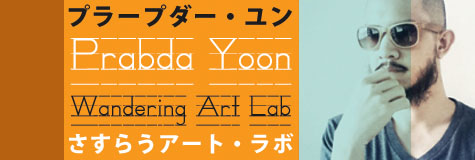
006 The Joyous Case of an Accidental Curator
Prabda Yoon
Writer and publisher
The first time I ever "curated" an art exhibition was when I was studying at Parsons School of Design in Manhattan. I didn't even know what a curator was at the time; my roommate and I were bored of our classes and we thought it would be fun to organize a group show of our friends' works. There was a small gallery in Parsons' Fifth Avenue building that was available for students to use free of charge, so we thought, Why not?
Strictly speaking, I was not an "art" student at the time. I was in my first year as a Communication Design major, thinking that I wanted to become a magazine art director, or something fashionable and stylish like that. As a teenager I went through a rather long phase of being a magazine addict, spending too much school allowance on all kinds of glossy periodicals I thought represented the latest and coolest social trends. I thought I wanted to belong in that world, until I stepped out of Fifth Avenue and ventured downward towards "the Village."
Even after making the big switch from Communication Design to Fine Arts, I still thought I was art director, rather than artist, at heart. I thought I was good at recognizing remarkable qualities in other creative people and could probably direct them and their works to appropriate venues. I was (and still am) extremely lazy, and even though I had a wheel of artistic ideas spinning in my head constantly, I'd much prefer to see other people execute those ideas than to carry them out myself. I thought I'd be a good organizer of some kind. I only found out later that a "curator" was someone who did exactly that in the art world.
But, as it turned out, I became a writer, and most of the art world activities soon receded from my life. I still made art regularly, more for pleasure than anything else, but I no longer kept up with what was happening in contemporary art, who was the hippest artist, what was the next big thing. I became neither an artist nor a curator.
However, probably because some people know of my hobby, I've been lucky enough to have been asked to curate several exhibitions. Despite my innate antisocial tendency and my growing ignorance of contemporary art, I've enjoyed collaborating with diverse artists on group exhibitions. I've generally found the experience to be touching and inspiring, as it's the kind of activity that reaffirms mutual creative drives among artists of all mediums. And the curator is lucky to be at the vantage point, to be able to observe these creative fireworks bursting together on the same canvas, in the same frame.
From March 24th to May 15th of 2011, I acted as curator (and participated as artist) for a small but well-known and internationally recognized gallery in Bangkok called 100 Tonson Gallery. It was a group exhibition of works by eight artists of various nationalities, namely Thai, Japanese, and Belgian. Strangely enough, of all the artists in the group I'm most familiar with the Japanese Nawa Kohei and Miyake Mai. All the Thai artists--except May-T Noijinda who is a famous musician--I knew and met for the first time.
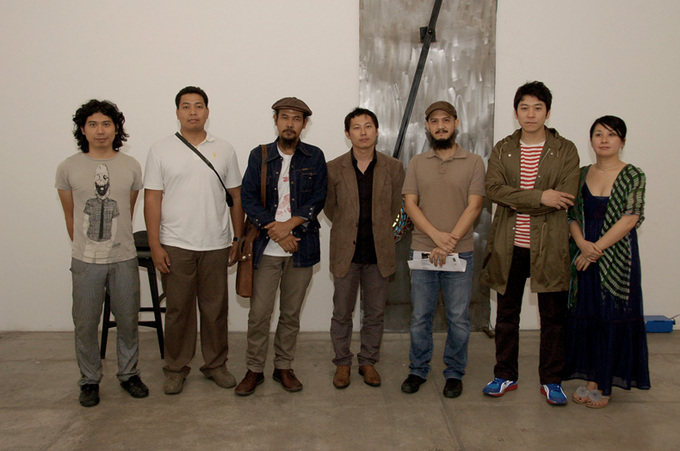
With the artists. From left, May-T Noyjinda, Krit Ngamsom, Zakareeya Amataya, Pasut Kranrattanasuit, myself, Nawa Kohei, and Miyake Mai (Peggy Wauters, the Belgian artist, could not attend)
The exhibition was called "Spiritutainment," which is a word mutated from the marriage of "spirituality" and "entertainment." The idea was to ask the participated artists to think about the relationship between spirituality (and/or religion) and entertainment. In many cultures the two are considered opposites, but I believe the contrary. However, it was not what I believed that inspired me to use the idea as the conceptual basis for the exhibition. I was interested in what other people thought about it, whether they thought about it at all. Here's what I wrote for the curator's statement:
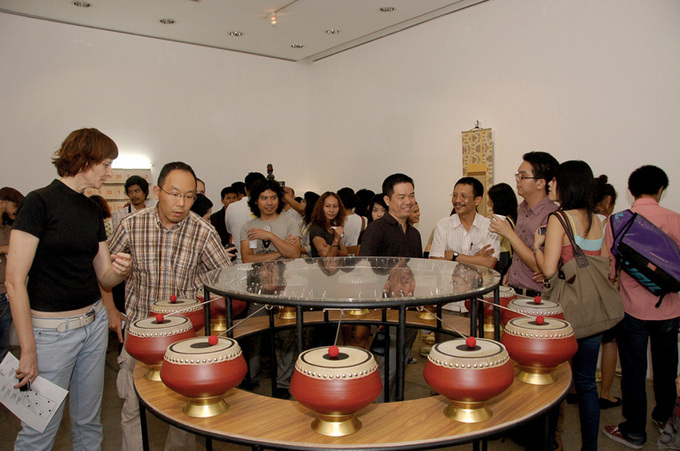
The general atmosphere at the opening night of Spiritutainment, 100 Tonson Gallery
My interest in spirituality and religion stems from my interest in philosophy. Historically, philosophy and spirituality often overlapped; it's perhaps even impossible to know for certain which appealed to human beings first. Almost all the ancient philosophies of the world contained some spiritual aspects, and vice versa. However, there is at least one crucial difference that separates the two: spirituality and religion--especially religion--imply some kind of faith in the supernatural, or the "divine," while philosophy can be totally materialistic. Philosophy can be in complete agreement with entertainment while many religions officially forbid it, or at least regard it as an inferior human preoccupation. I am interested in this awkward and curious relationship between entertainment and religion/spirituality. I wanted to get a dialogue going on the issue, through different artistic mediums, by artists from diverse backgrounds, both philosophically and spiritually. The exhibit is meant to be neither pessimistic nor optimistic toward religion/spirituality. I simply wanted to get "artistic" reactions, reflections, and interpretations from the artists in regards to the subject matter, with the hope to provoke a creative dialogue within the mind of the spectator. Art also works in mysterious ways.
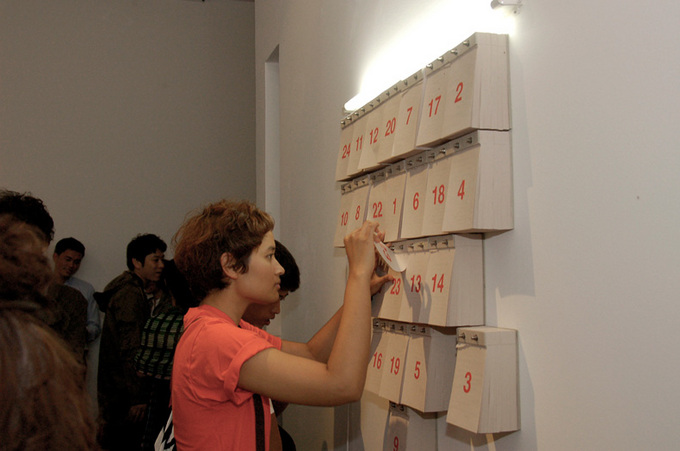
My own work, The Number God, is based on a popular fortunetelling technique
The exhibition was a good opportunity for me to meet and work with new contemporary Thai artists as well as to have the chance of introducing the works of my Japanese artist friends to Thailand. Nawa Kohei, is already a kind of celebrity among young Thai art enthusiasts. One of his popular Pix-celled Deer sculptures was displayed at the Bangkok Art Center for a time and it proved to attract many visitors. But Miyake Mai's work was totally new to the Thai public, and I think her God Has Many Names installation managed to impress the spectators with its delicate mixture of Japanese traditional craftsmanship and contemporary conceptual art sensibility. The exhibition happened not long after the March 11th Tsunami tragedy, so the presence of Japanese artworks and artists at the exhibition had a feeling that was completely unintended when the idea for the exhibition was formed.
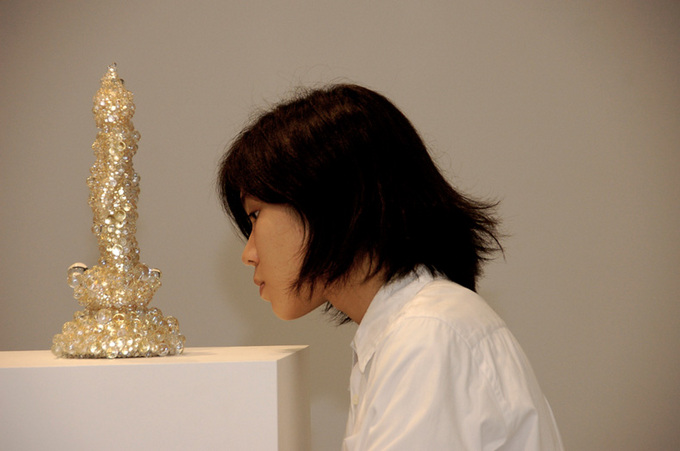
Nawa Kohei's Pix-celled Buddha getting a close inspection
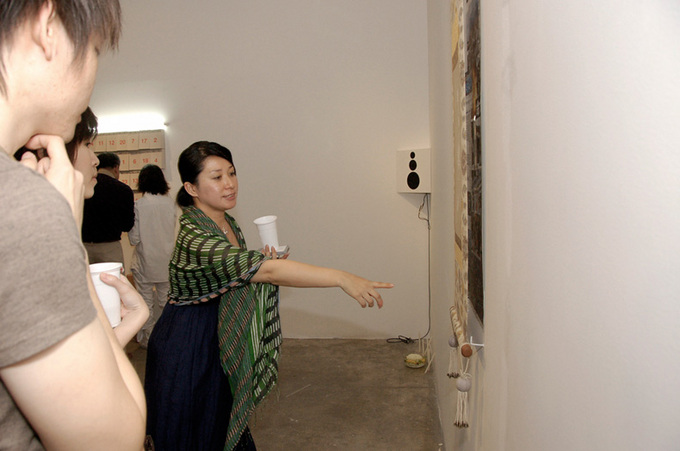
Miyake Mai explaining her work
It's always difficult to tell, with an exhibition with concept as abstract such as this, how "the message" effected the spectators, or whether communication occurred at all, but I thoroughly enjoyed the various ways the artists interacted with each other and with the visitors on the opening night. It was especially satisfying to see the artists who hardly knew each other getting along and sharing so well.
The creative spirit can strike instantly or it can seep in and work its way into a person's life slowly. That's beyond the curator's control. Nonetheless, the joy of being able to pick out ingredients, throw them into a bowl of art, and end up with a tasty, healthy dish is not an illusion.
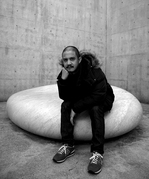 Prabda Yoon
Prabda Yoon
Born in 1973, a Thai writer and publisher based in Bangkok. He has published numerous novels, short story collections, and essay collections. In addition, he has also translated modern English-language classic literature such as The Catcher in the Rye and A Clockwork Orange into Thai. In 2002, his short story collection, Kwam Na Ja Pen (English: Probability), won the SEA Write Award.
Apart from working in Thailand, Prabda has regularly written for Japanese magazines and exhibited artworks in Japan. He has written 2 screenplays for films starring Tadanobu Asano and he is presently collaborating on various art projects with Japanese contemporary artist Kohei Nawa. His literary works have been translated into Japanese, of which the most recent is the novel Panda.
Back Issues
- 2022.7.27 Beyond Disasters - T…
- 2022.6.20 Beyond Disasters - T…
- 2021.6. 7 Contributed Article …
- 2021.4.28 Crossing Borders, En…
- 2021.4.27 Contributed Article …
- 2021.4.20 Contributed Article …
- 2021.3.29 Contributed Article …
- 2020.12.22 Interview with the R…
- 2020.12.21 Interview with the R…
- 2020.11.13 Interview with the R…

